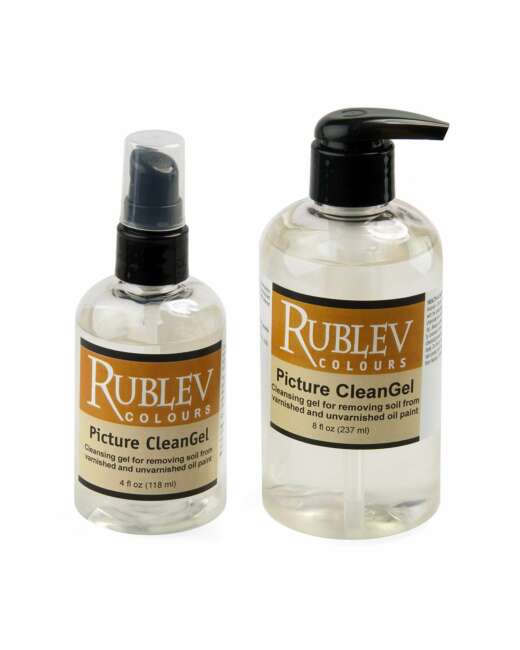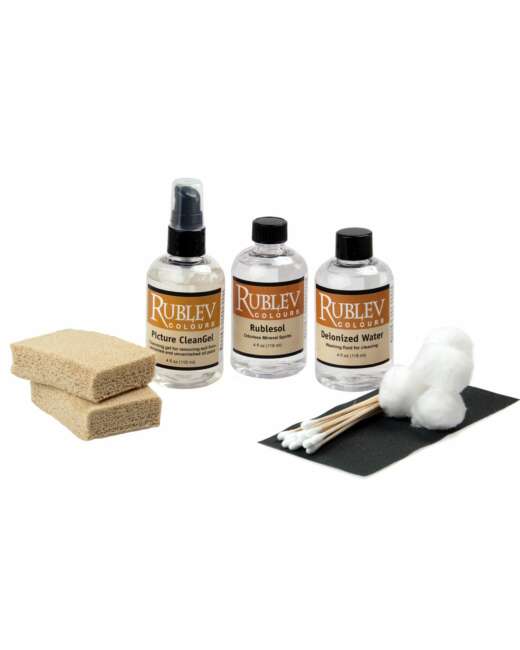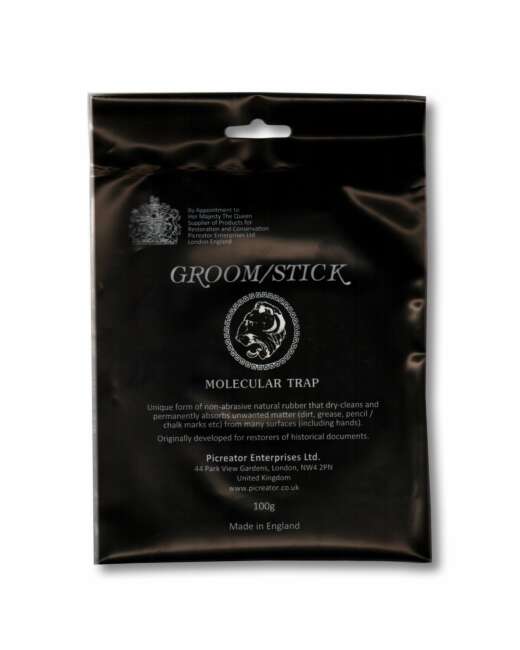Sani-Clean Spray
Sani-Clean Spray is for cleaning tools, utensils and containers for mixing paint or glue to prevent mold and germs that cause decay. Use to clean hard surfaces prior to painting and adhering. Contains: isopropyl alcohol, hydrogen peroxide, and purified water.
Sani-Clean Spray kills bacteria and mold that may cause decay in paint, sizes and adhesives. When preparing or mixing waterborne paint or sizes, such as animal collagen glue, bacteria and mold on surfaces of tools, utensils and containers may cause decay. In many cases, surfaces could be contaminated with bacteria and mold even when it's not visibly dirty. So it is important to eliminate bacteria and mold on these surfaces before using them to prepare paint, sizes and adhesives.
Sani-Clean Spray is effective for light-duty cleaning, but it is primarily a sanitizing spray designed to gently kill bacteria on hard, nonporous surfaces.
Ingredients
Isopropyl alcohol, hydrogen peroxide, deionized water.
Features
Kills bacteria and mold on hard, nonporous surfaces.
Spray on and leave. Doesn’t leave behind harmful residues or fumes.
Uses
Sanitize tools, utensils and containers prior to using to mix or prepare paint, adhesives, sizes and grounds.
Wipe down surfaces to remove contaminants such as dust and debris present from handling and manufacturing processes.
Clean surfaces of aluminum composite material (ACM) prior to priming or painting.
Strip surfaces of grime, grease, dust and dirt.
How to Use
Remove excess dirt.
Spray on surface until it is thoroughly wet.
Let stand for two minutes or more.
Wipe with clean, lint-free cloth or paper towel. If the surface is clean prior to spraying, there is no need to wipe or rinse with water as Sani-Clean Spray does not leave any residue.
Note: Do not use Sani-Clean Spray on varnished or unvarnished paintings as damage may result to the painting.
Frequently Asked Questions
Is it possible to sterilize with Sani-Clean Spray?
Terms like disinfect and sterilize are often misunderstood and used interchangeably. The Center for Disease Control (CDC) defines these terms clearly:
Unlike sterilization, disinfection is not sporicidal. A few disinfectants will kill spores with prolonged exposure times (3–12 hours); these are called chemical sterilants. At similar concentrations but with shorter exposure periods (e.g., 20 minutes for 2% glutaraldehyde), these same disinfectants will kill all microorganisms except large numbers of bacterial spores; they are called high-level disinfectants. Antiseptics are germicides applied to living tissue and skin; disinfectants are antimicrobials applied only to inanimate objects. In general, antiseptics are used only on the skin and not for surface disinfection, and disinfectants are not used for skin antisepsis because they can injure skin and other tissues. Virucide, fungicide, bactericide, sporicide, and tuberculocide can kill the type of microorganism identified by the prefix. For example, a bactericide is an agent that kills bacteria.
Sani-Clean Spray does not sterilize surfaces. Rather it is effective for killing bacteria and mold.
What is the difference between mold, mildew, fungi and bacteria?
Mold and bacteria are both microorganisms. Mold (US) or mould (UK / NZ / AU / ZA / IN / CA / IE) is a fungus that grows in the form of multicellular filaments called hyphae. Bacteria, on the other hand, is unicellular, or structurally a one-celled organism.
Fungus is a kingdom of organisms and mold is a diverse group of fungi in that kingdom. A fungus (plural: fungi or funguses) is any member of the group of eukaryotic organisms that includes microorganisms such as yeasts and molds, as well as the more familiar mushrooms.
Mildew is a type of fungus. It is distinguished from its closely related counterpart, mold, largely by its color: mold appears in shades of black, blue, red, and green, whereas mildew is white.
Is Sani-Clean Spray effective for cleaning mold and mold spores?
There are two active ingredients in Sani-Clean Spray: isopropyl alcohol and hydrogen peroxide. Isopropyl alcohol is effective in killing most bacteria, but is intermittently effective against fungus and is not effective against fungal spores. Hydrogen peroxide is more commonly associated with remedying mold and fungus outbreaks. Sani-Clean Spray contains both ingredients in the recommend amounts to effectively eliminate bacteria and mold.
Isn’t bleach more effective for killing mold?
Officially, government organizations are somewhat conflicted on the use of bleach for mold. The EPA does not recommend bleach. The CDC recommends bleach as part of a mold remediation effort. Bleach is harmful to artist materials, so it is not recommended to use as a sanitizer. Whie bleach is efective in stopping mold, it is also more invasive than Sani-Clean Spray for use in the studio.
Disclaimer
The content herein is for educational purposes only. It does not constitute a recommendation or suggestion. This information serves as a general guideline. All information is subject to change and requires a case-by-case consideration. The content herein, linked content or other web content provided makes no claims as to the final interpretations or implementation of state or federal policy provided by the FDA, OSHA, CDC, WHO, State Board of Pharmacy, the United States Pharmacopoeia (USP), and/or local authorities.
| SKU | 525-2216 |
|---|---|
| Brand | Rublev Colours |
| Vendor | Natural Pigments |
| Processing Time | Usually ships the next business day. |
| Size | 16 fl oz |










